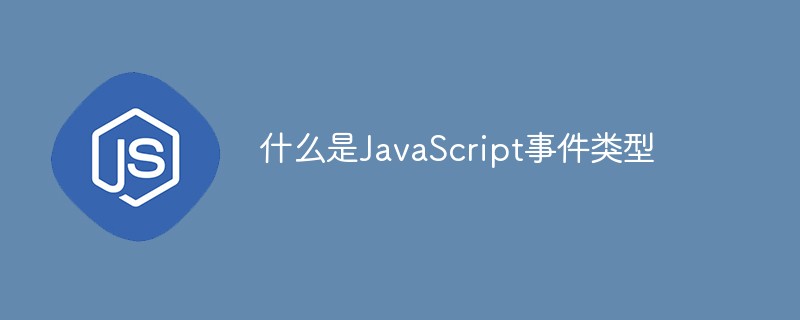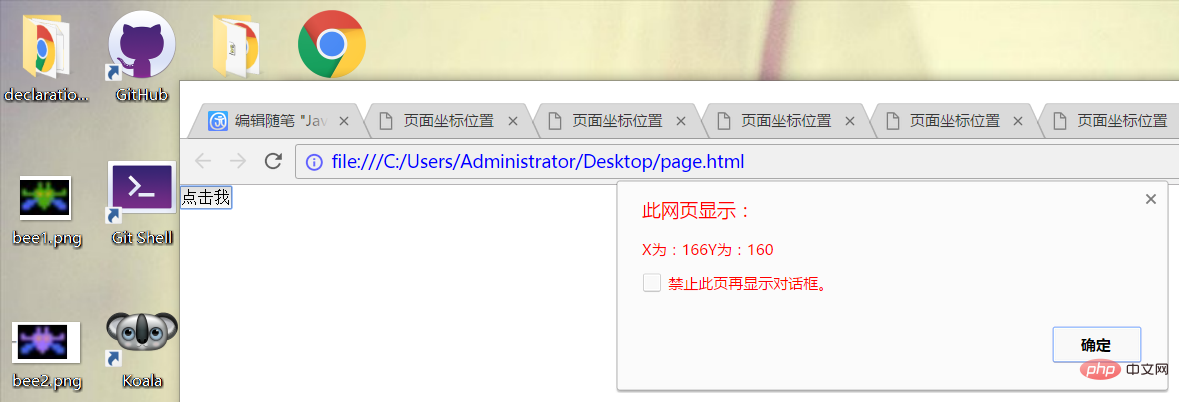Home > Article > Web Front-end > What are JavaScript event types
In JavaScript, event type refers to the way the event is triggered. A simple understanding is what event is triggered; event types include: UI events, focus events, mouse and wheel events, keyboard and text events, and compound events. , change events, HTML5 events, device events, touch and gesture events, etc.

The operating environment of this tutorial: windows7 system, javascript version 1.8.5, Dell G3 computer.
Events refer to behaviors that can be detected by JavaScript and are a "trigger-response" mechanism. These behaviors refer to specific actions such as page loading, mouse click/double-click, mouse pointer sliding over a certain area, etc. It plays a very important role in achieving the interactive effect of the page.
Events consist of three parts: event source, event type and event handler, also known as the "three elements of events".
Event source: the element that triggers (is) the event
Event type: the way the event is triggered (such as mouse click or keyboard click)
Event handler: code to be executed after the event is triggered (function form)
The above three elements can be simply understood as "who triggers event", "what event was triggered", "what to do after the event is triggered".
There are many types of events that may occur in web browsers. Here I will mainly focus on the following commonly used event types:
The UI in the UI event is (User Interface, User Interface), which is triggered when the user interacts with the elements of the page sauna.
UI events mainly include load, unload, abort, error, select, resize, scroll events.
1.load event
This event occurs when the page is completely loaded (including all images, js files, css external resources such as files), the load event on the window will be triggered.
This event is the most commonly used event in JavaScript. For example, we often use window.onload=function(){}; this form, that is, when the page Execute the functions after it is completely loaded.
In addition, I have never known that this event can also be used on other elements, such as image elements, as shown below:
24b0157c9e81669eddbc0e7346f6da55
That is, when the image is fully loaded There will be a pop-up window after coming out. Of course, it can also be implemented using JS, as shown below:
var img=document.getElementById("img");
EventUtil.addHandler(img,"load",function(){
event=EventUtil.getEvent(event);
alert(EventUtil.getTarget(event).src);
});2.unload event
Obviously, this event is relative to the load event of. Triggered after the document is completely unloaded. The unload time is triggered when the user switches from one page to another. The most common use of this event is to clear references to avoid memory leaks.
This event also has two ways to specify. One is the JavaScript method, using EventUtil.addHandler(); the other is to add a feature to the body element.
It is worth noting that you must be careful when writing the code in the onload event, because it is triggered after the page is unloaded, so Those objects that exist after the page is loaded may not necessarily exist after onload is triggered!
edd5d29a43d3fdae6e9c483e7ccef712
3.resize event
When the browser window is resized to a new width or height, the resize event is triggered. This event is triggered on the window. #So the handler can also be specified through the onresize attribute in JS or the body element.
79c1a952cdd0073d2f829668d9eae853
If you write this code, a window will pop up when the size of the browser changes.
4.scroll event
This event will be triggered repeatedly while the document is scrolled, so the code of the event handler should be kept as simple as possible.
焦点事件会在页面元素获得或失去焦点时触发。主要有下面几种:
注意:即使blur和focus不冒泡,也可以在捕获阶段侦听到他们。
鼠标事件是Web开发中最常用的一类事件,因为鼠标是最主要的定位设备。
注意到:上述所有事件除了mouseenter和mouseleave外都冒泡。
重要:只有在同一个元素上相继触发mousedown和mouseup事件,才会触发click事件。同样,只有在同一个元素上触发两次click事件,才会触发dbclick事件。
dbclick事件的产生过程如下:
mousedown
mouseup
click
mousedown
mouseup
click
dbclick
上面介绍了有关鼠标的事件,下面介绍一些对于鼠标光标的位置:客户区坐标位置、页面坐标位置、屏幕坐标位置
一、客户区坐标位置
通过客户区坐标可以知道鼠标是在视口中什么位置发生的。
clientX和clientY分别表示鼠标点击的位置。以body的左上角为原点,向右为X的正方向,向下为Y的正方向。这两个都是event的属性。举例如下:
8515479eab28241a7b375919bc70f9bf点我65281c5ac262bf6d81768915a4a77ac0
3f1c4e4b6b16bbbd69b2ee476dc4f83a
var button=document.getElementById("clickMe");
button.onclick=function(event){
alert(event.clientY+""+event.clientX);
};
2cacc6d41bbb37262a98f745aa00fbf0
当我点击按钮的左上角时,显示为00。效果如下:

二.页面坐标位置
和客户区坐标位置不同,页面坐标位置表示鼠标光标在页面而非视口中的位置。因此坐标是从页面本身而非视口的左边和顶边计算的。如果前面的话不能很好的理解,接着看这里:在页面没有滚动的情况下,页面坐标位置和客户区坐标位置是相同的。
页面坐标
76c82f278ac045591c9159d381de2c57
9fd01892b579bba0c343404bcccd70fb
93f0f5c25f18dab9d176bd4f6de5d30e
a80eb7cbb6fff8b0ff70bae37074b813
b2386ffb911b14667cb8f0f91ea547a7页面坐标位置6e916e0f7d1e588d4f442bf645aedb2f
c9ccee2e6ea535a969eb3f532ad9fe89
*{
margin:0;
padding:0;
}
p{
width: 800px;
height: 1200px; /*我的电脑的视口高度为960px;*/
background: #ccc;
} 531ac245ce3e4fe3d50054a55f265927
9c3bca370b5104690d9ef395f2c5f8d1
6c04bd5ca3fcae76e30b72ad730ca86d
e388a4556c0f65e1904146cc1a846bee94b3e26ee717c64999d7867364b1b4a3
be83eb51f340b921e483a6b46a36fe5f 点击我65281c5ac262bf6d81768915a4a77ac0
3f1c4e4b6b16bbbd69b2ee476dc4f83a
var button=document.getElementById("button");
button.onclick=function(){
alert("pageX为"+event.pageX+"pageY为"+event.pageY);
}; 2cacc6d41bbb37262a98f745aa00fbf0
36cc49f0c466276486e50c850b7e4956
73a6ac4ed44ffec12cee46588e518a5e
在上面的例子中,我把p的高设置为了1200px;而我的浏览器视口高度为960px;所以一定需要滚动我们才能点击按钮,最终得到的结果是:pageX为13pageY为1210。
然而IE8及更早的浏览器是不支持事件对象上的页面坐标的,即不能通过pageX和pageY来获得页面坐标,这时需要使用客户区坐标和滚动信息来计算了。而滚动信息需要使用document.body(混杂模式)、document.documentElement(标准模式)中的scrollLeft和scrollTop属性。举例如下:
be83eb51f340b921e483a6b46a36fe5f 点击我65281c5ac262bf6d81768915a4a77ac0
3f1c4e4b6b16bbbd69b2ee476dc4f83a var button=document.getElementById("button");
button.onclick=function(){
var pageX=event.clientX+(document.body.scrollLeft||document.documentElement.scrollLeft);
var pageY=event.clientY+(document.body.scrollRight||document.documentElement.scrollRight);
alert("pageX为"+pageX+"pageY为"+pageY);
};
2cacc6d41bbb37262a98f745aa00fbf0
此例子在IE浏览器下可得到同样结果。
三.屏幕坐标位置
与前两者又有所不同,鼠标事件发生时,还有一个光标相对于整个电脑屏幕的位置。通过screenX和screenY属性就可以确定鼠标事件发生时鼠标指针相对于整个屏幕的位置。举例如下:
76c82f278ac045591c9159d381de2c57
9fd01892b579bba0c343404bcccd70fb
93f0f5c25f18dab9d176bd4f6de5d30e
a80eb7cbb6fff8b0ff70bae37074b813
b2386ffb911b14667cb8f0f91ea547a7页面坐标位置6e916e0f7d1e588d4f442bf645aedb2f
c9ccee2e6ea535a969eb3f532ad9fe89
*{
margin:0;
padding:0;
} 531ac245ce3e4fe3d50054a55f265927
9c3bca370b5104690d9ef395f2c5f8d1
6c04bd5ca3fcae76e30b72ad730ca86d
be83eb51f340b921e483a6b46a36fe5f 点击我65281c5ac262bf6d81768915a4a77ac0
3f1c4e4b6b16bbbd69b2ee476dc4f83a
var button=document.getElementById("button");
button.onclick=function(){
alert("X为:"+event.screenX+"Y为:"+event.screenY);
};
2cacc6d41bbb37262a98f745aa00fbf0
36cc49f0c466276486e50c850b7e4956
73a6ac4ed44ffec12cee46588e518a5e
最终的结果如下:

显然screenX和screenY是相对于屏幕的左方和上方的。
四.修改键
当点击某个元素时,如果我们同时按下了ctrl键,那么事件对象的ctrlKey属性值将为true,否则为false,对于alt、shift、meta(windows键盘的windows键、苹果机的Cmd键)的事件属性altKey、shiftKey、metaKey同样如此。下面举例如下:
be83eb51f340b921e483a6b46a36fe5f 点击我65281c5ac262bf6d81768915a4a77ac0
3f1c4e4b6b16bbbd69b2ee476dc4f83a
var button=document.getElementById("button");
button.onclick=function(){
var array=new Array();
if(event.shiftKey){
array.push("shift");
} if(event.ctrlKey){
array.push("ctrl");
} if(event.altKey){
array.push("alt");
} if(event.metaKey){
array.push("meta");
}
alert(array.join(","));
};
2cacc6d41bbb37262a98f745aa00fbf0
这个例子中,我首先创建了一个array数组,接着如果我按下了那几个键,就会存入相应的名称。这里我同时按下了四个键,结果如下:

即最终将数组中的四个值拼接成了字符串显示出来。
3f1c4e4b6b16bbbd69b2ee476dc4f83a
document.onmousewheel=function(){
alert(event.wheelDelta);
};
2cacc6d41bbb37262a98f745aa00fbf0
当我向下滚动滚轮时,效果如下:

该部分主要有下面几种事件:
keydown:当用户按下键盘上的任意键时触发。按住不放,会重复触发。
keypress:当用户按下键盘上的字符键时触发。按住不放,会重复触发。
keyup:当用户释放键盘上的键时触发。
textInput:这是唯一的文本事件,用意是将文本显示给用户之前更容易拦截文本。
这几个事件在用户通过文本框输入文本时才最常用到。
键盘事件:
document.addEventListener("keydown",handleKeyDownClick,false);
function handleKeyDownClick(event) {
var e = event||window.event||arguments.callee.caller.arguments[0];
if (e&&e.keyCode == 13) {
alert("keydown");
}
}
【相关推荐:javascript学习教程】
The above is the detailed content of What are JavaScript event types. For more information, please follow other related articles on the PHP Chinese website!